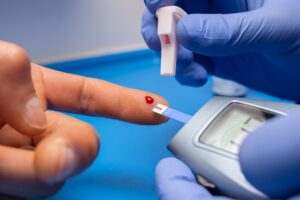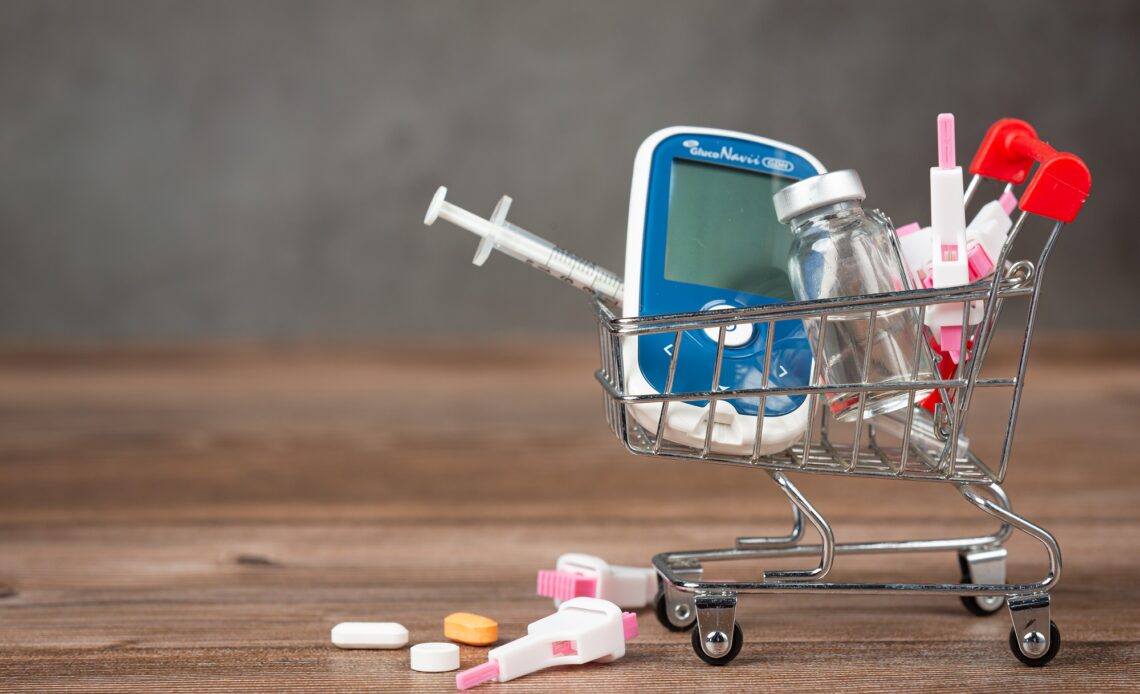Understanding Diabetes
Diabetes is a chronic disease that occurs when the pancreas cannot produce enough insulin or when the body cannot effectively use the insulin it produces. Insulin is a hormone that regulates blood sugar.
There are two main types of diabetes:
- Type 1 Diabetes: The body does not produce insulin. It is an autoimmune disease where the immune system attacks the insulin-producing cells in the pancreas. Type 1 diabetes is usually diagnosed in childhood or early adulthood.
- Type 2 Diabetes: The body does not produce enough insulin or cannot use it effectively. This is the most common type of diabetes, occurring in adults but increasingly being diagnosed in children and teens due to obesity and lack of exercise.
The main symptoms of diabetes include:
- Frequent urination
- Increased thirst and appetite
- Weight loss
- Fatigue
- Blurred vision
Diabetes is diagnosed through blood tests that measure blood sugar levels. An A1C test measuring average blood sugar over the past 2-3 months is also used.
Risk factors for type 2 diabetes include:

- Obesity
- Lack of physical activity
- Family history
- Age over 45
- Gestational diabetes during pregnancy
- High blood pressure
- Abnormal cholesterol levels
Dietary Changes
Making changes to your diet is one of the most effective ways to manage diabetes at home. The goal is to eat foods that help keep your blood sugar levels stable.
Recommended Diets
Certain diets like the Mediterranean, DASH (Dietary Approaches to Stop Hypertension), and low-carb diets are recommended for people with diabetes. These diets emphasize eating more vegetables, fruits, whole grains, healthy fats, lean protein, nuts and seeds. They limit added sugars, refined carbs, and unhealthy fats. Following these healthy eating patterns can improve blood sugar control.
Controlling Carbs
It’s important to pay attention to the amount and types of carbs you eat. Carbs break down into glucose and directly impact blood sugar levels. Try to limit carb-heavy foods like bread, pasta, rice, baked goods, and starchy vegetables. Focus on getting carbs from high fiber whole foods. Spread carb intake evenly throughout the day to prevent blood sugar spikes. Work with a dietitian to determine your optimal carb intake.
Portion Control and Meal Planning
Portion control and meal planning are key for managing diabetes. Read nutrition labels and be mindful of serving sizes. Make meals around healthy carb portions. Plan ahead for meals and snacks so you make mindful choices. Meal prep can set you up for success. Having portioned healthy options on hand prevents going for quick, high-carb fixes when hunger strikes.
Exercise
Regular exercise is a crucial part of managing diabetes at home. Both aerobic activity and strength training help improve insulin sensitivity and blood sugar control.
Aerobic exercise includes any activity that increases your heart rate, such as walking, jogging, cycling, or swimming. Aim for at least 150 minutes per week of moderate-intensity aerobic activity. This could be 30 minutes 5 days a week. Aerobic exercise helps improve insulin sensitivity and lowers blood sugar levels.
Incorporating strength training 2-3 times per week is also recommended. Strength training builds muscle mass which helps improve glucose metabolism. Focus on major muscle groups like legs, back, chest, abs, shoulders, and arms. Use bodyweight exercises, resistance bands, free weights, or weight machines. Be sure to give muscles at least 24 hours of rest between strength sessions.
Avoid remaining sedentary for long periods of time. Take breaks to get up and move around throughout the day. Go for a walk, do some stretches, or perform bodyweight exercises like squats or lunges. The more active you are, the better your blood glucose levels will be.
Making exercise a consistent habit is key for diabetes management. Work with your healthcare provider to develop a safe, effective physical activity plan. Staying active provides significant benefits for blood sugar control and overall health.
Medications
Diabetes requires close management of blood sugar levels. Medications can help keep blood sugar in a healthy range and prevent complications.

Common medications prescribed for diabetes include:
- Metformin: This oral medication helps lower blood sugar by reducing glucose production in the liver and improving how insulin works. Metformin is often prescribed as a first-line treatment for type 2 diabetes. Take metformin with food to avoid stomach upset.
- Sulfonylureas: These oral pills stimulate the pancreas to release more insulin. Examples are glyburide, glipizide, and glimepiride. Side effects can include low blood sugar and weight gain.
- Insulin: People with type 1 diabetes require insulin injections to survive. Those with type 2 diabetes may eventually need insulin shots if other medications are not enough to control blood sugar. Insulin helps get glucose from the bloodstream into the body’s cells.
- GLP-1 receptor agonists: Injectable non-insulin medications that lower blood sugar and reduce appetite. Exenatide (Byetta) and liraglutide (Victoza) are examples. Side effects can include nausea and gallbladder problems.
Proper usage of diabetes medications involves taking the correct dosage at the right time each day. Follow the prescribing doctor’s instructions carefully. Never skip or adjust doses without medical guidance. Monitor blood sugar regularly to ensure medications are working effectively. Report any concerning side effects to your healthcare provider right away. Consistent use of diabetes medications as directed can significantly improve blood sugar control.
Blood Sugar Monitoring
Monitoring your blood sugar levels is a critical part of managing diabetes at home. This allows you to track how food, exercise, stress, and medications affect your blood glucose levels. The key aspects of monitoring include:
Checking Blood Glucose Levels
– Check your blood sugar levels several times a day, especially before meals and bedtime. The frequency depends on your diabetes type and treatment plan.
– Test at consistent times each day for the most useful data. Checking first thing in the morning provides your fasting baseline glucose level.
– Wash your hands before testing to avoid skewing the results.
Using a Glucometer
– Use a portable glucometer device to check your blood sugar anytime. These provide quick digital readouts with only a small blood sample from your fingertip.
– Lancet devices allow for easy blood sampling with disposable needle tips. Replace lancets regularly to minimize pain and prevent infection.
– Follow the manufacturer’s instructions to get accurate results. Calibrate your glucometer periodically.
Maintaining Logs
– Record your blood glucose readings in a daily log along with food, medication, exercise and other factors.
– Bring your logs to doctor’s appointments. Logging trends over time provides useful data to optimize your diabetes management plan.
– There are also digital apps and glucometers that store results electronically in a log for convenience.
Carefully monitoring blood glucose provides vital feedback to stabilize levels and prevent complications. Work closely with your healthcare provider to utilize blood sugar data and adjust your diabetes regimen as needed. Consistency and diligence with checking and logging is key.
Complications
Diabetes can cause serious complications over time if blood sugar levels are not well controlled. The high levels of glucose in the bloodstream that occur in diabetes can damage nerves, kidneys, eyes, heart and blood vessels. Preventing and managing complications is crucial for people with diabetes.
Nerve damage (neuropathy):
Uncontrolled diabetes can cause damage to nerves throughout the body. This can lead to numbness, loss of sensation, and sometimes pain in the extremities. Neuropathy can also affect digestive organs, urinary systems, sexual function and heart rate. Keeping blood sugar levels as close to normal as possible can help prevent nerve damage from worsening over time. Medications, physical therapy, surgery and pain management can also help treat neuropathy symptoms.
Kidney disease (nephropathy):
High blood sugar causes damage to blood vessels in the kidneys, limiting their ability to filter waste. This can eventually lead to kidney failure or end stage renal disease (ESRD) which requires dialysis or kidney transplant. Kidney damage often has no symptoms in its early stages, so get routine urine and blood tests to monitor kidney health. Controlling blood sugar and blood pressure levels, medications, diet changes and early treatment can prevent or delay kidney disease progression.
Eye damage (retinopathy):
Uncontrolled diabetes affects the small blood vessels that provide blood to the retina, causing them to leak and distort vision. Retinopathy often has no early warning signs. Regular eye exams and early treatment with laser surgery can minimize vision loss. Keeping blood sugar levels close to target range is key to prevent retinopathy progression.
Heart disease and stroke:
Diabetes dramatically increases the risk of various cardiovascular problems like heart attack, stroke, heart failure and narrowing of arteries. High blood glucose damages blood vessels and makes blood more likely to clot. Managing cholesterol levels, blood pressure, weight, and not smoking can lower cardiovascular risks. Medications to treat high blood pressure and cholesterol are often needed as well.
The key to preventing complications is keeping blood sugar levels as close to the target range as possible through medications, diet, exercise and regular monitoring. Work closely with your doctor for screening tests to monitor for early signs of complications. Prompt treatment can prevent complications from worsening over time. Make nutrition and lifestyle changes to manage diabetes and live an active, healthy life.
Foot Care
Keeping your feet healthy is crucial when you have diabetes. High blood sugar levels can cause nerve damage that reduces feeling in your feet, making you less likely to notice injuries or irritation. Diabetes also impairs circulation and slows healing. Following proper foot care habits can help prevent serious complications.
Inspect your feet daily
Set aside time each day to thoroughly examine your feet and between your toes. Check for cuts, blisters, redness, swelling, calluses, or other problems. Use a hand mirror to see the bottoms of your feet. Notify your doctor of any abnormalities.
Prevent foot injuries
Wear proper fitting shoes and socks at all times. Don’t walk barefoot, even indoors. Check your shoes for objects or tears before putting them on. When outside, wear shoes appropriate for the conditions and watch where you step.
Practice good hygiene and moisture management
Wash your feet daily in lukewarm water. Be sure to dry thoroughly, especially between the toes. Apply moisturizing lotion, avoiding between the toes. Wear moisture wicking socks and change them frequently if they become damp. Let your shoes completely dry between wearings.
Eye Care
Getting regular eye exams is crucial for people with diabetes. High blood sugar levels can damage the blood vessels in the retina and lead to diabetic retinopathy, one of the leading causes of blindness. All people with diabetes should get a comprehensive dilated eye exam at least once a year.
During the eye exam, the eye doctor will put drops in your eyes to dilate the pupils and examine the retina for signs of damage. They may see leaking blood vessels, deposits, swelling, or changes in color that indicate retinopathy. Early detection and timely treatment are key to preventing vision loss.
If retinopathy is caught early, it may be reversible through laser surgery that stops abnormal blood vessels from leaking. For more advanced retinopathy, injections of medication into the eye may help prevent further vision loss. Managing your blood sugar, blood pressure, and cholesterol can also slow the progression of retinopathy.
Other diabetes-related eye conditions like cataracts and glaucoma can also cause vision problems. Cataract surgery and prescribed eyedrops are treatment options. Let your eye doctor know if you experience any vision changes, as prompt treatment is essential for maintaining clear vision.
With diligent eye care, people with diabetes can protect their eyesight. Be sure to schedule regular eye exams and follow your doctor’s recommendations for managing eye health. Proper diabetes control can lower your risk of developing vision complications.
Dental Care
Oral health is extremely important for people with diabetes. High blood sugar levels can increase your risk for gum disease, cavities, tooth loss, dry mouth, fungal infections, and other dental problems. Maintaining excellent dental hygiene and scheduling regular dental cleanings and exams is essential.
Maintaining dental hygiene
– Brush your teeth at least twice a day with a soft-bristle toothbrush. Make sure to brush all surfaces – front, back, top, and tongue.
– Floss daily to remove plaque from between teeth. Use a floss holder if dexterity is an issue.
– Use antimicrobial mouthwash to reduce bacteria.
– If your mouth is dry, drink water frequently and use sugar-free gum or lozenges. Ask your dentist about prescription saliva substitutes.
Managing gum disease
Gum disease is a major complication of diabetes. Pay close attention to gum tenderness, redness, swelling, or bleeding. See your dentist right away if you notice any symptoms.
Good oral hygiene and professional cleanings help prevent and control gum disease. Your dentist may recommend more frequent cleanings or dental treatments to manage gum inflammation. Controlling your blood sugar is also key.
Scheduling regular cleanings
Most people with diabetes should see a dentist every 3-6 months for a professional cleaning and exam. Inform your dentist that you have diabetes so they can monitor you closely for any oral health issues. Regular cleanings will help catch problems early.
Support System
Managing diabetes can feel overwhelming at times. Having a strong support system is critical.
Involving family and friends allows them to understand what you are going through. They can assist with shopping, cooking, and providing encouragement. Open communication ensures they know how to spot signs of high or low blood sugar and how to respond.
Joining community organizations and online support groups connects you with others living with diabetes. You can share experiences, exchange tips, and feel less alone. Many local hospitals and clinics offer in-person group meetings. Facebook groups, subreddits, and forums provide online support.
Assembling a care team gives you access to expert help. This may include your primary care doctor, an endocrinologist, diabetes educator, registered dietitian, and other specialists. They can answer your questions, adjust medications, provide nutrition advice, and monitor your overall health. Regular appointments ensure you get professional guidance.
Having a diverse support system helps make diabetes management easier. Don’t be afraid to ask for help from those who care about you.


